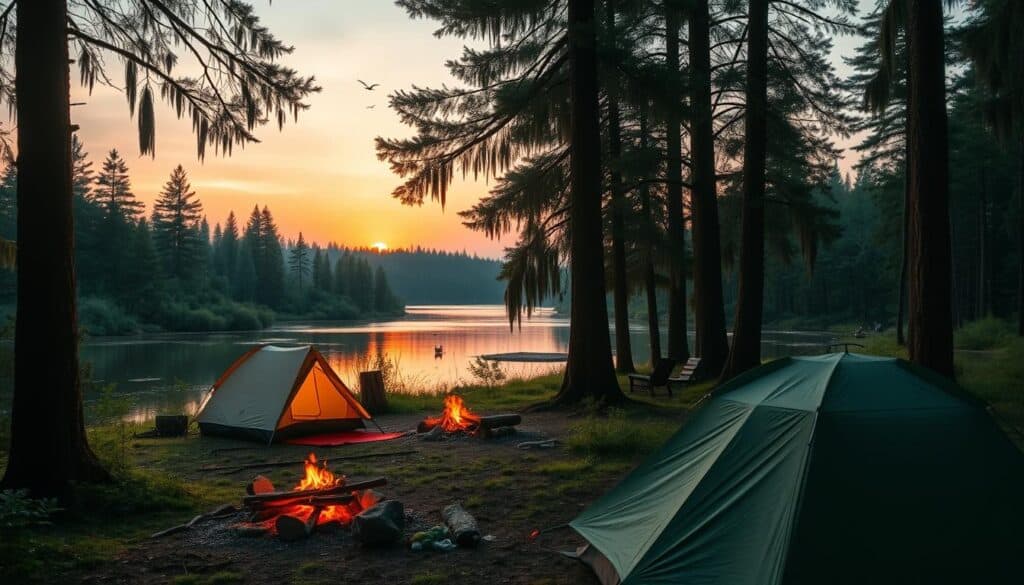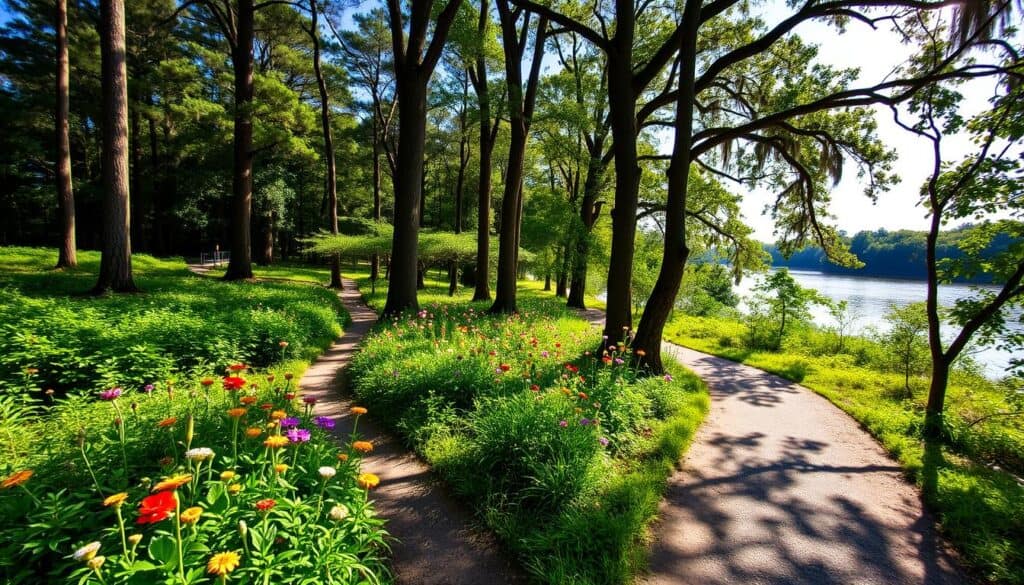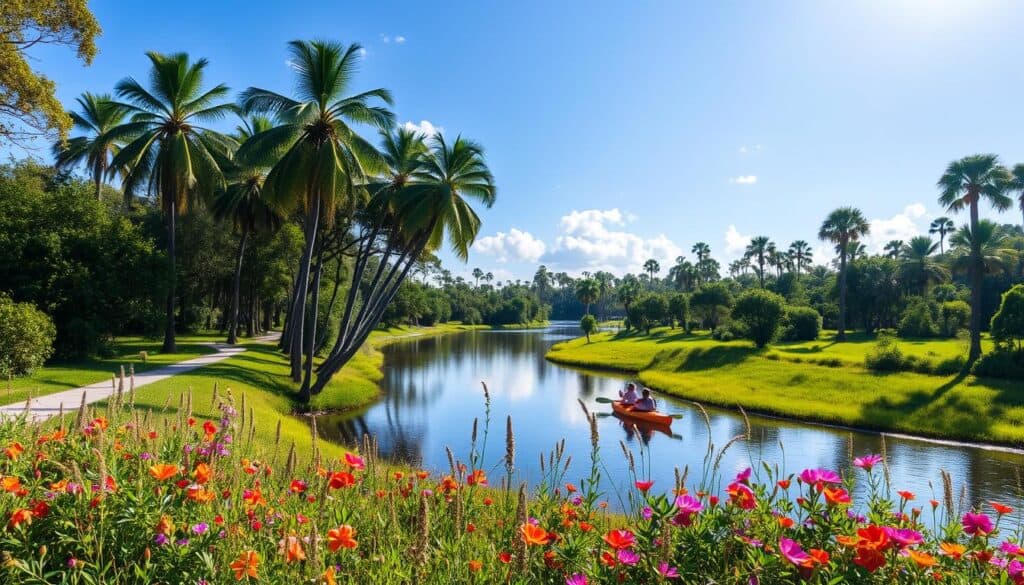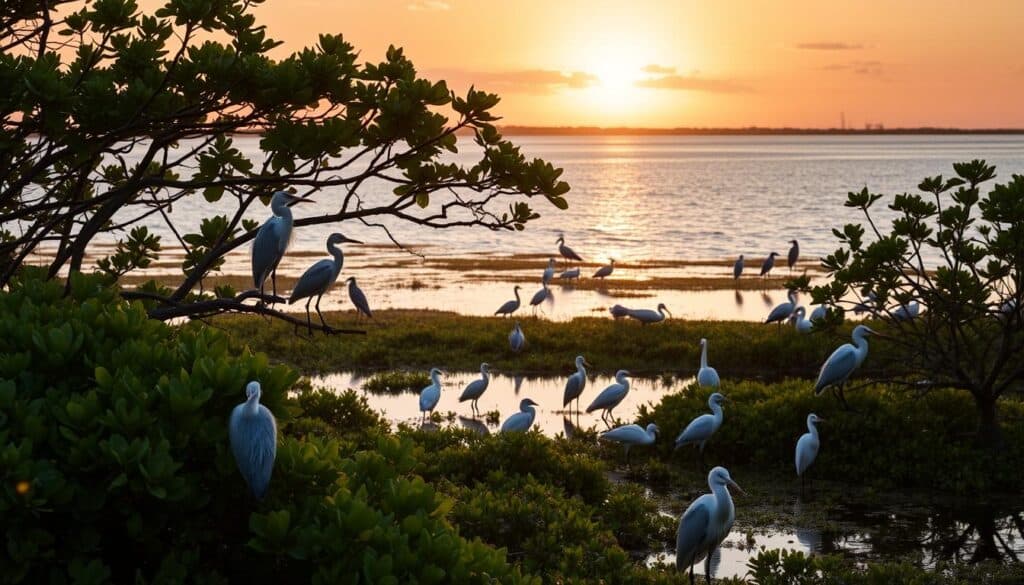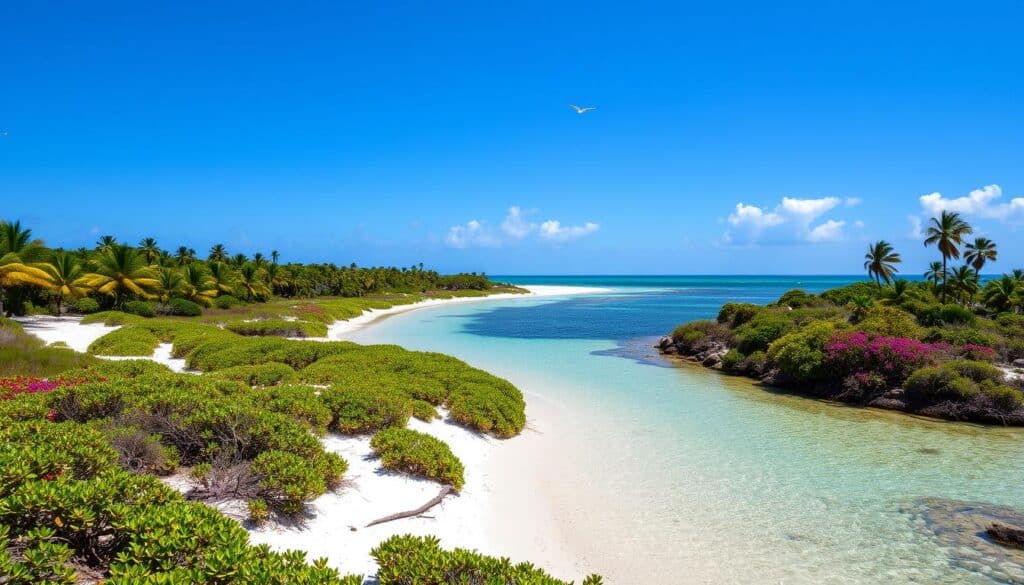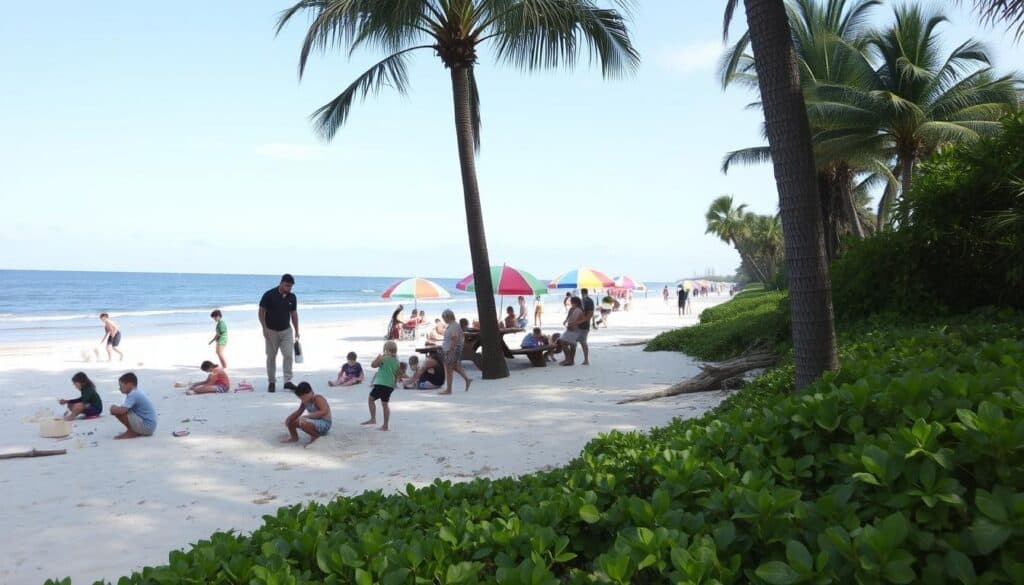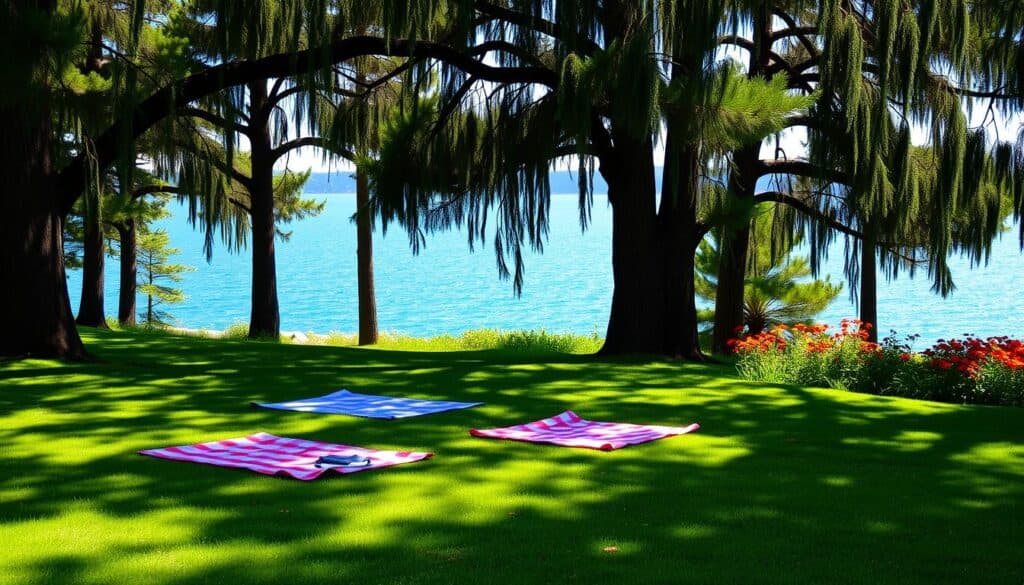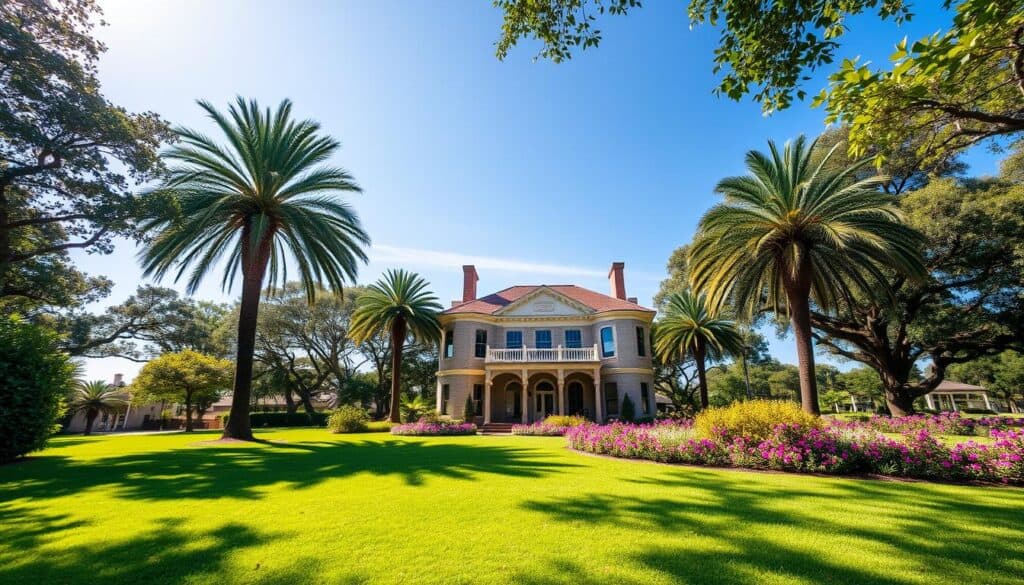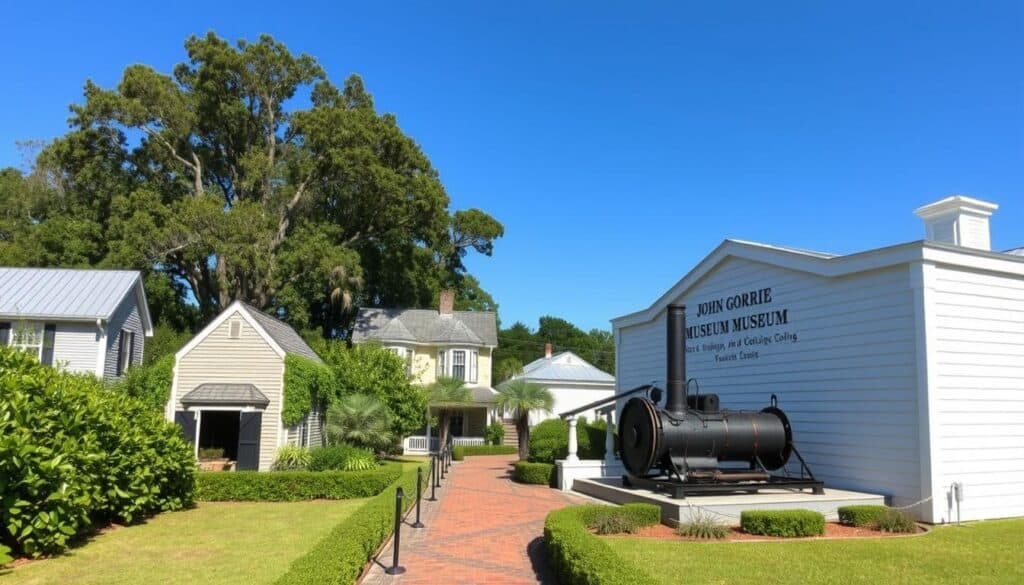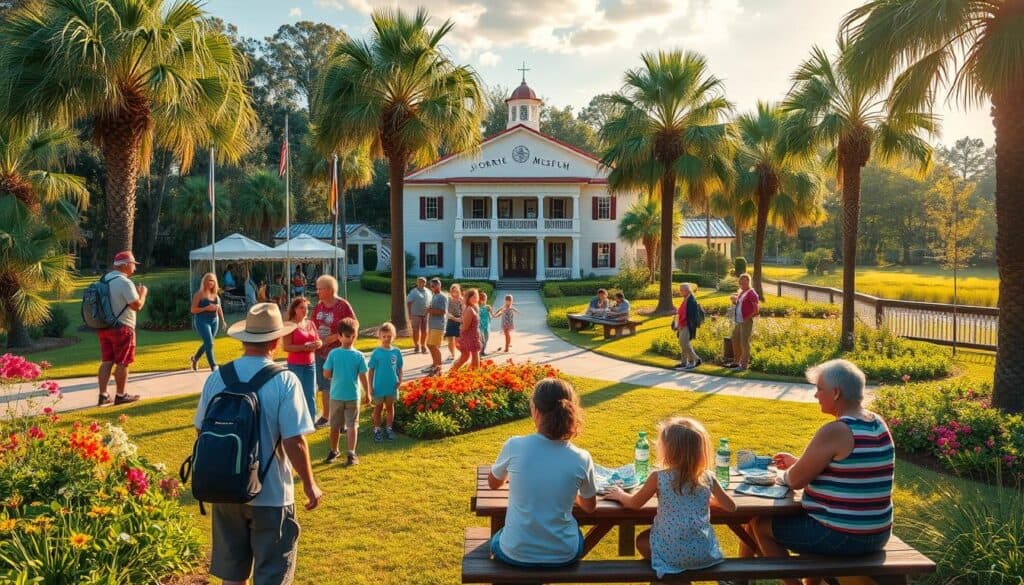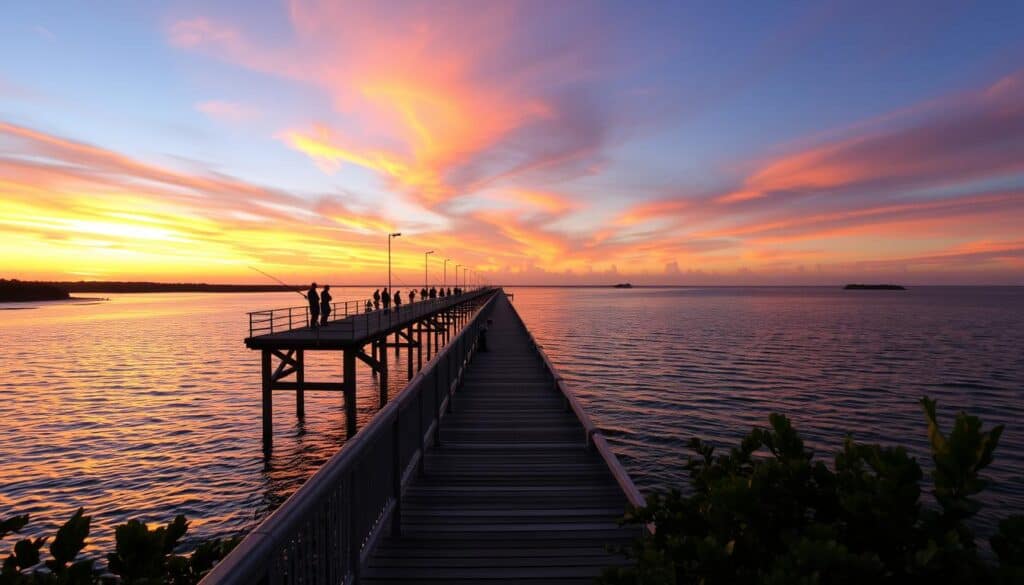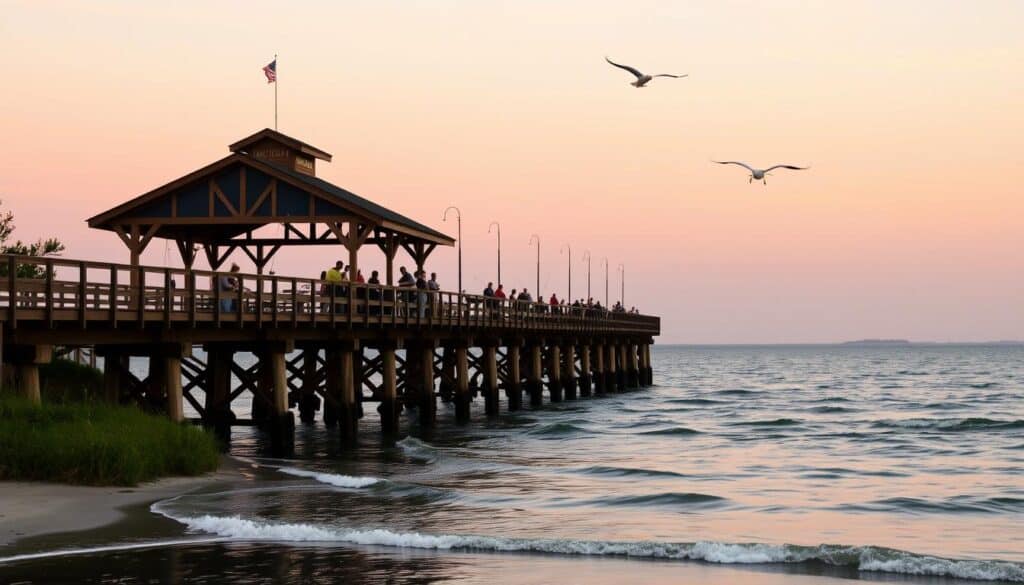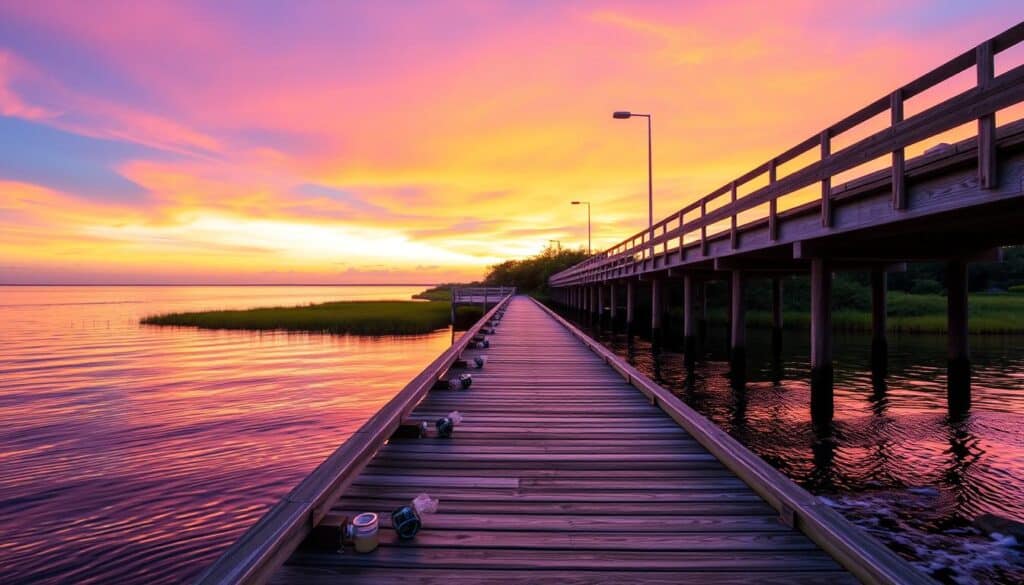Located in Citrus County, Florida, Homosassa Springs Wildlife State Park is a unique natural oasis that invites visitors to explore the state’s native wildlife. As a Florida wildlife park, it offers a glimpse into the serene beauty of the region’s ecosystem. With its crystal-clear springs and extensive natural areas, the park is an ideal destination for those interested in eco-tourism and wildlife conservation.
Homosassa Springs Wildlife State Park is approximately 70 miles from Tampa International Airport, making it easily accessible for tourists. The park’s guided tours, wildlife encounters, and educational programs make it a popular spot for school groups and families. With its focus on preserving native species and their habitats, the park has gained national attention for its conservation efforts.
Key Takeaways
- Homosassa Springs Wildlife State Park is a 200-acre natural oasis in Citrus County, Florida.
- The park offers guided tours, wildlife encounters, and educational programs for visitors.
- It is known for its birdwatching opportunities and underground observatory where visitors can observe manatees and fish up close.
- The park has a program for rehabilitating injured and orphaned manatees, contributing to wildlife conservation efforts.
- Visitors can enjoy the park’s natural beauty and learn about Florida’s native wildlife at Homosassa Springs Wildlife State Park.
- The park is open daily from 9 AM to 5:30 PM, with peak visitation occurring from November to April during manatee season.
- Homosassa Springs Wildlife State Park is a must-visit destination for nature lovers and those interested in eco-tourism and wildlife conservation.
Introduction to Homosassa Springs Wildlife State Park
Located in Homosassa Springs, Florida, the Homosassa Springs Wildlife State Park is a captivating natural oasis that showcases the state’s diverse wildlife. The park is home to a variety of species, including manatees in Florida, and offers nature trails in Florida for visitors to explore.
The park’s unique features make it an ideal destination for nature lovers and those interested in wildlife conservation. With its natural communities, including hydric hammock, depression marsh, and mesic flatwoods, the park provides a habitat for numerous species of plants and animals.
Brief Overview of the Park
The park spans 200.25 acres, with 133.82 acres dedicated to the hydric hammock natural community. Visitors can explore the park’s nature trails in Florida, which include a 1.1-mile loop trail and an additional 1.5-mile optional round-trip route.
Importance of Wildlife Conservation
The park plays a vital role in wildlife conservation, with a focus on protecting and preserving the natural habitats of its inhabitants. The park is home to manatees in Florida, as well as other species, and offers a range of activities and programs to promote conservation and education.
Some of the park’s notable features and activities include:
- Wildlife viewing areas
- Nature trails and scenic walks
- Wildlife presentations and educational programs
- Manatee rehabilitation and conservation efforts
Wildlife Species at Homosassa Springs
Homosassa Springs Wildlife State Park is renowned for its diverse range of wildlife, making it a must-visit destination for nature enthusiasts and those interested in Bird watching in Florida. The park’s unique ecosystem supports a wide variety of species, including the iconic manatee, which can be observed in its natural habitat. This experience is a prime example of Eco-tourism in Florida, where visitors can learn about and appreciate the state’s natural beauty while supporting conservation efforts.
The park is home to several native bird species, including majestic birds of prey and colorful songbirds. Visitors can enjoy Bird watching in Florida at its best, with numerous species to spot and learn about. The park’s wildlife refuge is also home to other animals, such as alligators, deer, and bobcats, making each visit a thrilling adventure into the heart of Florida’s wildlife.
Some of the notable wildlife species found at Homosassa Springs include:
- Manatees
- Native bird species, such as herons, egrets, and hawks
- Alligators
- Deer
- Bobcats
These species, along with others, contribute to the park’s rich ecosystem and make it an ideal location forEco-tourism in Florida. By visiting Homosassa Springs, visitors can support conservation efforts and experience the beauty of Florida’s natural wildlife.
Park Activities for Visitors
At Homosassa Springs Wildlife State Park, visitors can enjoy a variety of activities that combine education with recreation. The park offers guided tours and educational programs, providing in-depth insights into the park’s ecosystem and the importance of conservation. One of the popular activities is the wildlife tour, which allows visitors to get up close and personal with the park’s resident animals.
For those who prefer to explore on their own, the park features Nature trails in Florida that wind through scenic landscapes and offer breathtaking views of the surrounding wildlife. The Pepper Creek Trail, approximately 0.75 miles long, is a great spot for birding and nature walks. Visitors can also enjoy boat tours, which provide a unique perspective on the park’s ecosystem.
Some of the activities and their costs are:
- Adult ticket price: $13 USD
- Child ticket price (ages 6-12): $5 USD
- Children under 5: Free admission
- Boat tours: $3 for ages 13 and up; $2 for kids ages 6-12; free for children under 5 and Florida State Park Pass holders
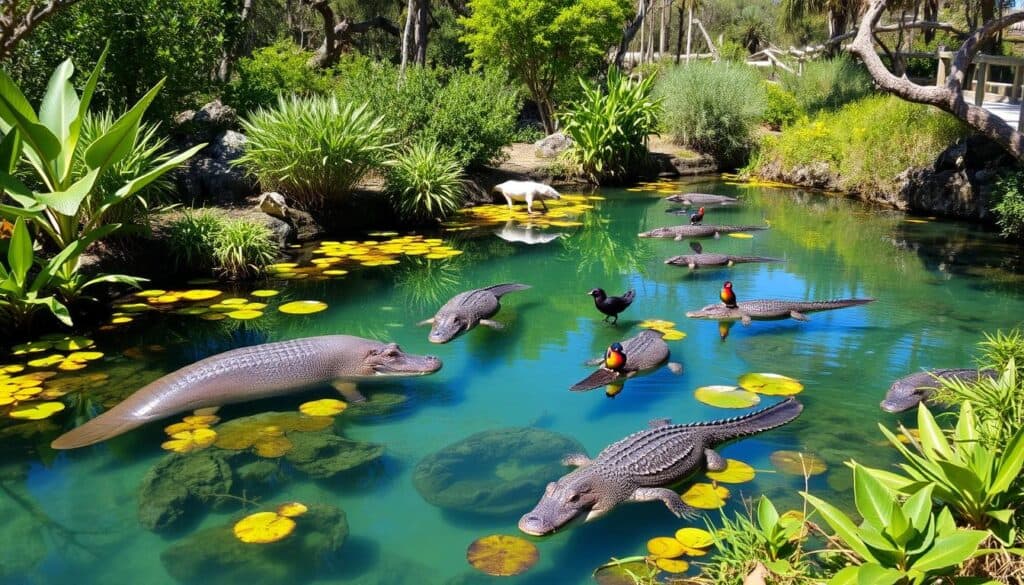
Whether you’re interested in learning about Florida’s native species or simply enjoying the beauty of nature, Homosassa Springs Wildlife State Park has something for everyone. With its unique blend of education and recreation, the park is an ideal destination for families, nature lovers, and anyone looking to experience the best of Florida wildlife park and Nature trails in Florida.
| Activity | Cost | Duration |
|---|---|---|
| Wildlife Tour | $13 USD (adult) | 1-2 hours |
| Boat Tour | $3 (ages 13 and up) | 1 hour |
| Nature Trail | Free | Self-guided |
Seasonal Highlights at the Park
Homosassa Springs Wildlife State Park is a dynamic destination that changes with the seasons, offering unique experiences and attractions throughout the year. Visitors can enjoy Manatees in Florida during the spring season, as these gentle creatures congregate in the warmer waters of the springs.
In the fall, the park is a haven for Bird watching in Florida, with numerous species passing through the park on their journey to warmer climates. The fall season brings the spectacle of bird migration, making it an ideal time for bird enthusiasts to visit the park.
- Manatee season in the spring, which begins in November
- Bird migration in the fall, with numerous species passing through the park
- Daily wildlife tours and educational programs, which provide insight into the park’s diverse wildlife
Visitors can plan their trips according to these seasonal highlights, ensuring they make the most of their visit and enjoy the park’s diverse wildlife during its most active periods. With its unique offerings and attractions, Homosassa Springs Wildlife State Park is a must-visit destination for nature lovers and wildlife enthusiasts.
Facilities and Amenities
Homosassa Springs Wildlife State Park offers a range of facilities and amenities to enhance the visitor experience, making it an ideal destination for Citrus County nature attractions. The park’s commitment to Eco-tourism in Florida is evident in its efforts to provide a comfortable and enjoyable visit for all.
The park features a visitor center, which is the perfect place to start your journey, providing valuable information about the park’s history, wildlife, and activities. The gift shop is a great spot to find souvenirs and memorabilia, supporting the park’s conservation efforts.
Visitor Center and Gift Shop
The visitor center and gift shop are conveniently located, offering a range of services and products that cater to visitors’ needs. Some of the amenities include:
- Information about the park’s history and wildlife
- Guided tours and educational programs
- Souvenirs and memorabilia
Picnic Areas and Restrooms
Picnic areas and restrooms are conveniently located throughout the park, allowing visitors to relax and recharge while taking in the natural beauty of their surroundings. These amenities are a testament to the park’s commitment to Eco-tourism in Florida, making it an accessible and enjoyable destination for nature lovers and families.

Accessibility Features
At Homosassa Springs Wildlife State Park, a Florida wildlife park, accessibility is a top priority. The park’s pathways and trails are designed to be accessible for individuals with disabilities, allowing everyone to explore the natural beauty of the area. Visitors can enjoy the Nature trails in Florida and experience the unique wildlife and ecosystems of the park.
The park offers various services for individuals with disabilities, including wheelchair-accessible observatories and walkways, as well as tram services for visitors with physical disabilities. Some of the accessible features and services offered by the park and other similar parks in Florida include:
- Wheelchair-accessible pathways and trails
- Wheelchair-accessible observatories and walkways
- Tram services for visitors with physical disabilities
- Free beach wheelchairs upon request
- Elevated boardwalks and paved trails for access to wildlife viewing
These features and services ensure that all visitors can participate in the park’s activities and enjoy its attractions, making Homosassa Springs Wildlife State Park an inclusive and welcoming destination for everyone.
| Park | Accessible Features |
|---|---|
| Homosassa Springs Wildlife State Park | Wheelchair-accessible observatories and walkways, tram services |
| Little Manatee River State Park | Gravel trails, wooden ramps for restrooms, new boat ramp with handrails |
| Alafia River State Park | Three ADA-accessible campsites, accessible showers |
Guided Tours and Special Events
Homosassa Springs Wildlife State Park offers a variety of guided tours and special events that cater to different interests and ages, making it an ideal destination for Bird watching in Florida enthusiasts and those interested in Eco-tourism in Florida. The park’s daily wildlife presentations provide visitors with a unique opportunity to learn about the diverse species that call the park home, including manatees, alligators, and numerous bird species.
Some of the special events and activities include:
- Daily wildlife presentations
- Special weekend programs for families and children
- Guided nature walks and bird watching tours
- Educational programs for schools and groups
These events and activities are designed to promote a deeper understanding and appreciation of Florida’s natural heritage, while also supporting the park’s Eco-tourism in Florida efforts. By participating in these guided tours and special events, visitors can gain a unique perspective on the park’s diverse wildlife and ecosystems, including the best spots for Bird watching in Florida.

The park’s commitment to conservation and education is evident in its partnerships with organizations such as the Florida Wildlife Commission and U.S. Fish and Wildlife Service. By visiting Homosassa Springs Wildlife State Park and participating in its guided tours and special events, visitors can contribute to the park’s conservation efforts and support the protection of Florida’s natural resources.
| Event | Frequency | Duration |
|---|---|---|
| Daily Wildlife Presentations | Daily | 30 minutes |
| Special Weekend Programs | Weekends | 1-2 hours |
| Guided Nature Walks | Weekly | 1-2 hours |
Nearby Attractions
Located in the heart of Citrus County, Homosassa Springs Wildlife State Park is surrounded by a plethora of nature attractions that complement its offerings. Visitors can explore the nearby Crystal River, renowned for its manatee population, and discover the local history of the area by visiting numerous sites and museums.
Some of the top Citrus County nature attractions include the Chassahowitzka National Wildlife Refuge, which spans 31,000 acres, and the Seven Sisters, a cluster of springs featuring short underwater tunnels carved in limestone by spring forces. The Gulf of Mexico, Homosassa River, and Chassahowitzka River are prime locations for paddling, boating, and fishing, with anglers able to catch both saltwater and freshwater species due to the brackish river waters.
Exploring the Crystal River
The Crystal River is a must-visit destination for anyone interested in wildlife, particularly manatees. Visitors can take a guided tour or rent a boat to explore the river and its surrounding areas. The river is also home to a variety of bird species, making it a paradise for birdwatchers.
Discovering Local History
The area is steeped in history, with numerous sites and museums that offer insights into the region’s past. Visitors can learn about the early settlers of the area, the indigenous people, and the role of the river in the region’s development. The local history is a fascinating aspect of the area, and visitors can spend hours exploring the various sites and museums.
With its rich natural and cultural heritage, Homosassa Springs Wildlife State Park is an ideal base for exploring the wider area. By combining a visit to the park with explorations of the nearby attractions, visitors can gain a more comprehensive understanding of Citrus County’s nature attractions and Florida wildlife park, creating lasting memories of their trip.
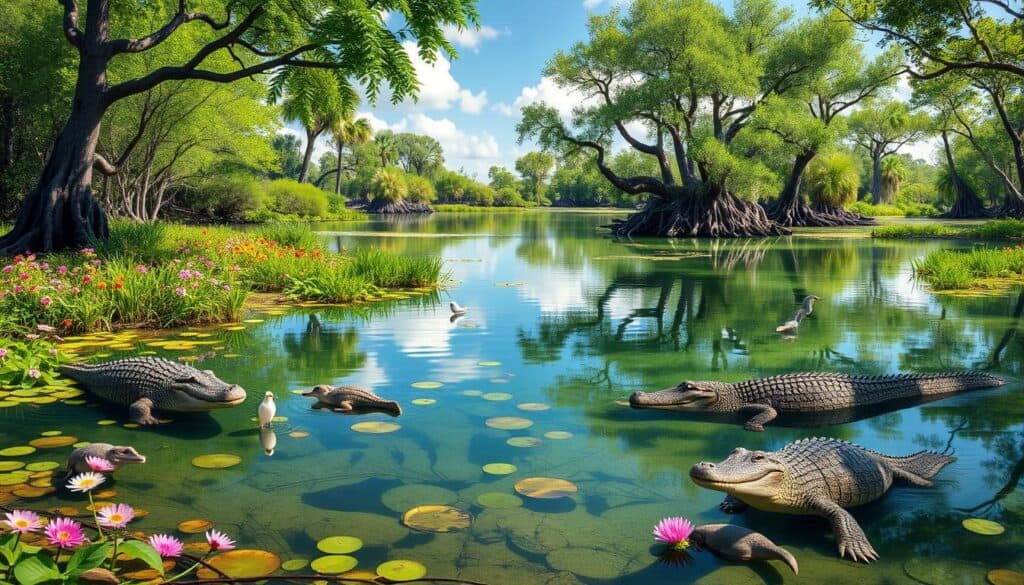
| Attraction | Description |
|---|---|
| Crystal River | Renowned for its manatee population |
| Chassahowitzka National Wildlife Refuge | Spans 31,000 acres |
| Seven Sisters | Cluster of springs with underwater tunnels |
Tips for Planning Your Visit
When planning your visit to Homosassa Springs Wildlife State Park, it’s essential to consider the best times to visit and what to bring. The park is open 365 days a year, from 9:00 AM to 5:30 PM, with last admission at 4:00 PM. To make the most of your visit, consider arriving early to explore the Nature trails in Florida and spot Manatees in Florida during the cooler months.
To ensure a safe and enjoyable experience, be sure to bring comfortable clothing, sunscreen, and binoculars for bird watching. You can find more information on the park’s website or by visiting the visitor center. By being prepared and planning ahead, you can make the most of your time at the park and its surrounding natural beauty.
Here are some additional tips to keep in mind:
- Check the park’s hours of operation and plan your visit accordingly
- Bring plenty of water and snacks to stay hydrated and energized
- Wear comfortable shoes and clothing suitable for outdoor activities
By following these tips and being prepared, you can have a safe, enjoyable, and memorable experience at Homosassa Springs Wildlife State Park, surrounded by the beauty of Nature trails in Florida and the majesty of Manatees in Florida.
| Best Time to Visit | Activities |
|---|---|
| Spring and Fall | Manatee watching and bird migration |
| Summer | Nature trails and scenic walks |
Conservation Efforts and Environmental Education
Homosassa Springs Wildlife State Park plays a vital role in the conservation of Florida’s wildlife and ecosystems. The park’s conservation efforts are multifaceted, ranging from the protection of manatees and their habitats to the preservation of natural areas and the promotion of eco-tourism practices in Florida.
Through collaborations with local organizations, the park contributes to a broader network of conservation initiatives, supporting the long-term health and biodiversity of the region. By engaging in environmental education, the park inspires visitors to become involved in conservation, fostering a sense of responsibility and stewardship for the natural world, which is essential for bird watching in Florida and other outdoor activities.
Park’s Role in Protecting Wildlife
The park is home to a variety of wildlife, including manatees, birds, and gopher tortoises. The park’s conservation efforts focus on protecting these species and their habitats, as well as promoting eco-tourism in Florida and environmental education.
Collaborations with Local Organizations
The park collaborates with local organizations to protect wildlife and promote environmental education. These collaborations support the park’s mission to conserve and protect Florida’s natural resources, making it an ideal destination for eco-tourism in Florida and bird watching in Florida.
Some of the park’s conservation efforts include the protection of submerged aquatic vegetation, the monitoring of water quality parameters, and the establishment of Minimum Flows and Levels to regulate water discharge and maintain ecological health.
Conclusion: Embracing Nature at Homosassa Springs Wildlife State Park
As the sun sets on your journey through Homosassa Springs Wildlife State Park, it’s clear that this natural oasis is more than just a destination – it’s a testament to the beauty and importance of preserving Florida’s
wildlife
and
nature attractions
. The park’s commitment to sustainable tourism and environmental education sets a shining example for visitors, inspiring a deeper appreciation for the delicate balance of our ecosystems.
Whether you’ve come to witness the gentle manatees, explore the lush trails, or simply immerse yourself in the tranquility of the springs, Homosassa Springs has left an indelible mark. As you depart, we invite you to carry this experience with you, sharing the wonders of this
Citrus County
gem with friends and family. By embracing the park’s message of conservation and responsible stewardship, you can help ensure that Homosassa Springs remains a vibrant, thriving sanctuary for generations to come.
As you plan your next adventure, we encourage you to explore other remarkable
Florida wildlife parks
and natural wonders that make our state a treasure trove for outdoor enthusiasts. With each visit, you’ll not only create lasting memories but also contribute to the preservation of America’s natural heritage, ensuring that these captivating landscapes remain accessible and protected for all to enjoy.
FAQ
What is Homosassa Springs Wildlife State Park?
Homosassa Springs Wildlife State Park is a captivating natural oasis in Florida that invites visitors to immerse themselves in the serene beauty of the state’s wildlife. It is a sanctuary for nature lovers and families, offering a unique opportunity to explore native species like manatees, alligators, and numerous bird species.
What kind of wildlife can visitors see at the park?
The park is home to a wide range of wildlife, including the iconic manatees, as well as alligators, deer, and a diverse array of bird species. Visitors can observe these animals in their natural habitats and learn about the importance of wildlife conservation.
What activities and amenities are available at Homosassa Springs Wildlife State Park?
The park offers a variety of activities and amenities, including wildlife tours, educational programs, nature trails, picnic areas, and visitor facilities like a gift shop and restrooms. It is designed to engage visitors of all ages and provide an enriching experience.
When is the best time to visit the park?
The park offers unique experiences throughout the year, with the spring and fall seasons being particularly popular for manatee watching and bird migration, respectively. Visitors can plan their trips to coincide with these seasonal highlights.
How accessible is the park for visitors with disabilities?
Homosassa Springs Wildlife State Park is dedicated to providing an inclusive experience for all visitors. The park’s pathways and trails are designed to be accessible, and it offers services for individuals with disabilities, ensuring that everyone can participate in the park’s activities and enjoy its attractions.
What are the conservation efforts at the park?
The park plays a vital role in the conservation of Florida’s wildlife and ecosystems. Its conservation efforts include the protection of manatees and their habitats, the preservation of natural areas, and the promotion of eco-tourism practices. The park also engages in environmental education to inspire visitors to become involved in conservation.


